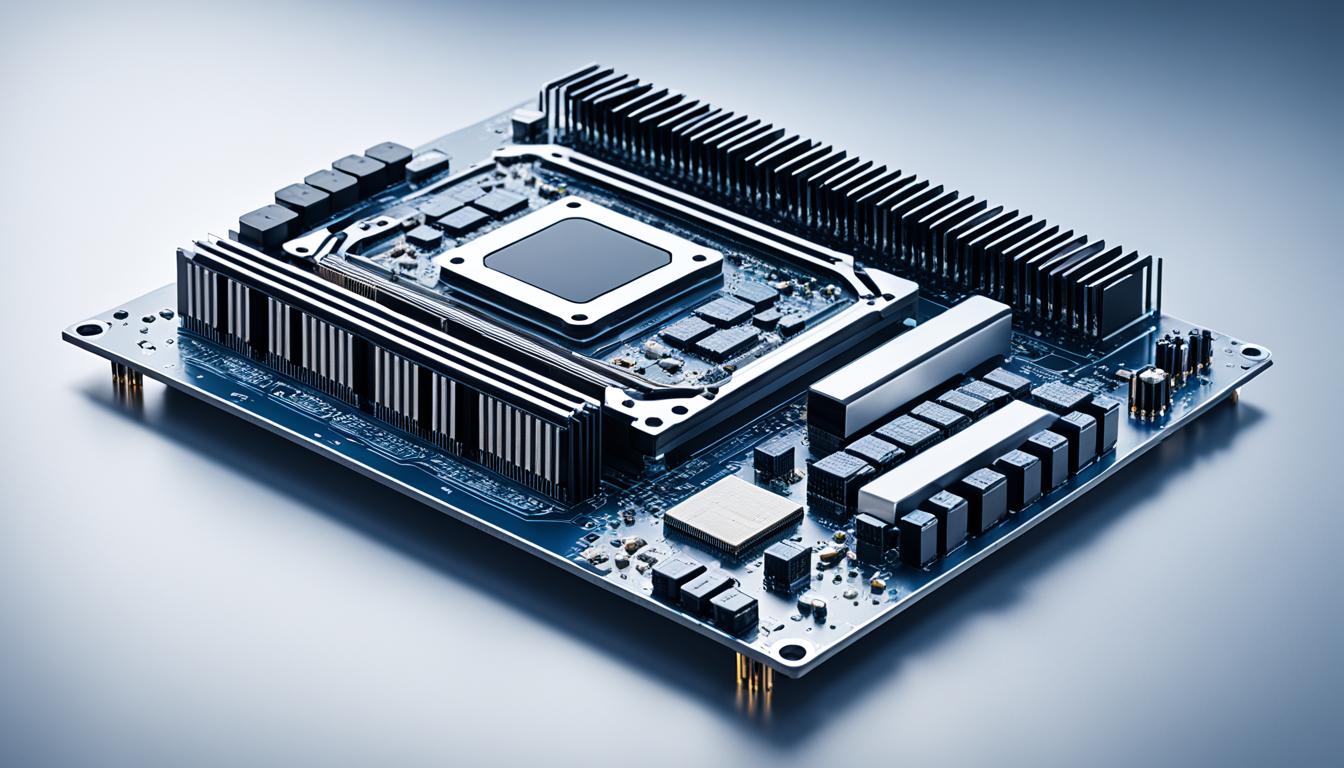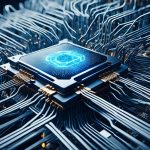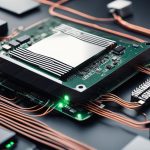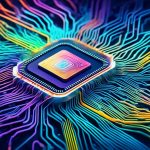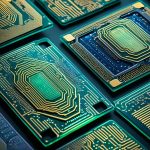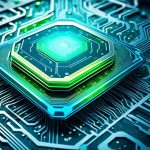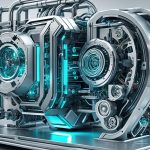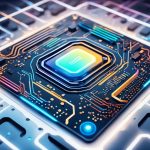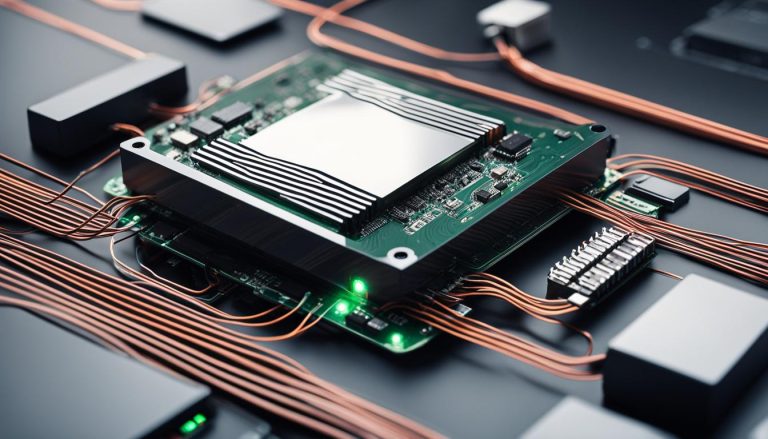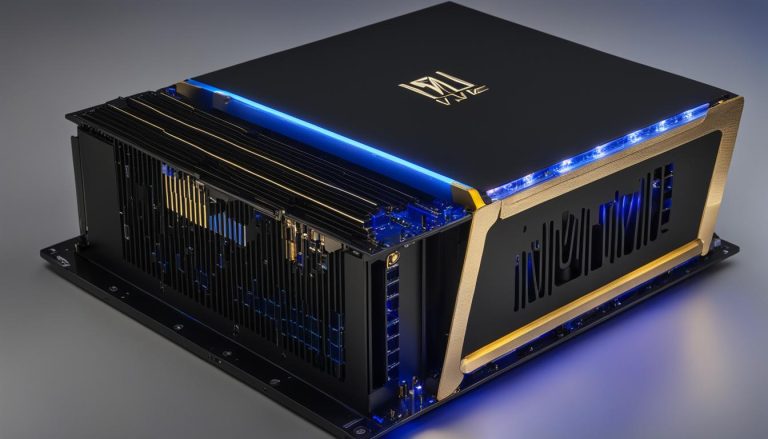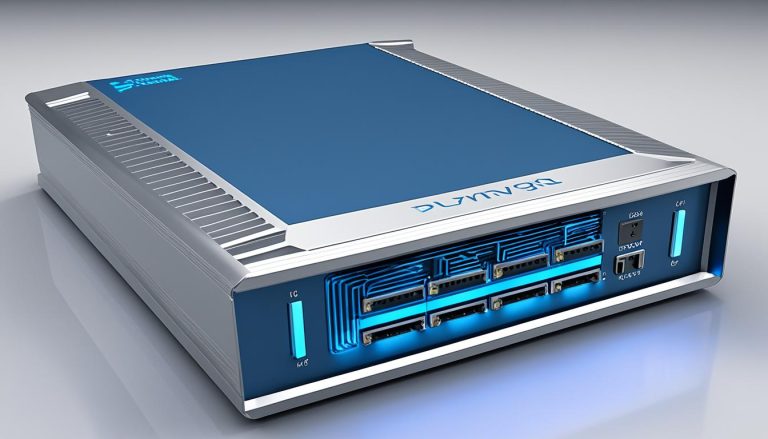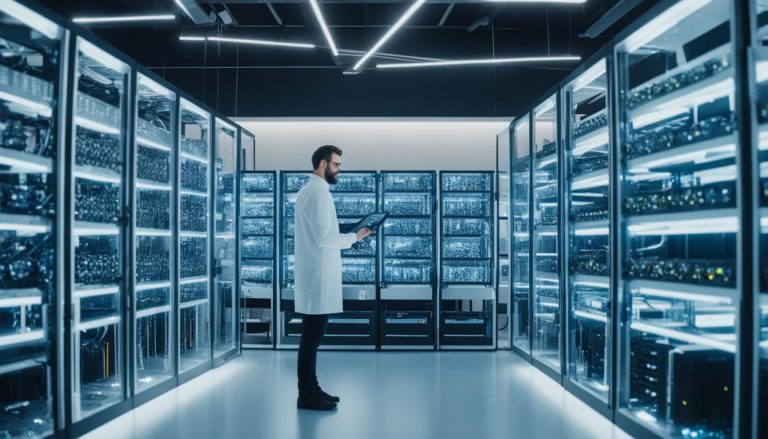AI hardware customization is revolutionizing the field of artificial intelligence by optimizing neural network performance. As AI continues to grow and evolve, traditional hardware solutions like CPUs are proving to be insufficient for the demands of AI workloads. Specialized hardware, such as GPUs, NPUs, and edge computing devices, has emerged as key advancements in AI hardware, enhancing AI computations and enabling real-time decision-making capabilities.
In this article, we will explore the evolution, significance, and technological trends in AI hardware customization, highlighting the benefits and future implications of using AI-optimized hardware in various industries.
Key Takeaways:
- AI hardware customization improves neural network performance in AI applications.
- Specialized hardware like GPUs, NPUs, and edge computing devices optimize AI computations.
- AI-optimized hardware enables real-time decision-making capabilities.
- The future of AI hardware holds immense potential for advancements and innovations.
- AI hardware customization is shaping the future of AI development and deployment.
The Evolution and Significance of AI Hardware
Traditional hardware solutions, like CPUs, are no longer sufficient for the growing complexity and scale of AI. Specialized hardware designed specifically for AI tasks has emerged as a solution. Specialized GPUs, initially designed for graphics processing, have found new applications in AI due to their parallel processing capabilities. NPUs, on the other hand, are designed exclusively for neural network computations, offering optimized performance for AI workloads. Additionally, edge computing devices have revolutionized AI deployment by enabling on-device processing at the edge of the network. These advancements in AI hardware have significantly contributed to the development and deployment of AI solutions.
Specialized GPUs, such as those from Nvidia’s RTX series, have become one of the key drivers in AI hardware evolution. These GPUs, which excel at parallel processing, were originally developed for gaming and visual rendering. However, their ability to perform large-scale computations in parallel makes them highly suitable for AI workloads. The parallel architecture of GPUs allows for efficient computation, enabling faster training and inference of AI models.
The advancements in specialized GPUs have unlocked new possibilities in AI research and development. Their computational power, paired with AI algorithms, has fueled breakthroughs in fields such as image and speech recognition, natural language processing, and autonomous vehicles.
Neural Processing Units (NPUs) are another significant development in AI hardware. These specialized chips are designed exclusively for neural network computations, providing optimized performance and power efficiency. NPUs excel at handling the complex calculations involved in training and inference of AI models, enabling faster and more efficient AI computations.
Edge computing devices have also emerged as a game-changer in the AI hardware landscape. These devices enable on-device processing at the edge of the network, closer to the data source. This approach reduces latency and bandwidth requirements, allowing for real-time decision-making capabilities. By processing data locally, edge computing devices enhance privacy and security, making them highly suitable for applications that require quick and secure AI computations.
Edge computing devices have enabled AI applications in various industries, such as healthcare, manufacturing, and transportation. From remote patient monitoring to predictive maintenance and autonomous drones, edge devices have revolutionized AI deployment and made real-time AI applications a reality.
The evolution of AI hardware has had a profound impact on the development and deployment of AI solutions. With the advancements in specialized GPUs, NPUs, and edge computing devices, AI researchers and developers have gained access to powerful tools that accelerate innovation and enhance performance. These AI-optimized hardware solutions drive the growth of AI in industries ranging from healthcare and finance to automotive and retail.
The image above illustrates the evolution of AI hardware, showcasing the transition from traditional CPUs to specialized GPUs, NPUs, and edge computing devices. This visual representation highlights the importance of AI hardware evolution in enabling advanced AI applications and unlocking new possibilities in various industries.
Advancements in AI Hardware: A Closer Look
When it comes to AI development, specialized GPUs have emerged as a game-changing advancement in AI hardware. These GPUs provide the computational power necessary for deep learning tasks, allowing for efficient training and inference of AI models. Their parallel processing capabilities ensure that AI computations are executed swiftly and effectively.
Another significant advancement in AI hardware is the development of Neural Processing Units (NPUs). NPUs are purpose-built chips designed specifically for neural network computations. With their specialized hardware acceleration, NPUs make AI computations faster and more efficient. This optimization enables AI models to perform complex tasks with improved accuracy and precision.
Edge computing devices have also revolutionized the AI hardware landscape. By enabling the deployment and processing of AI models at the edge of the network, closer to the data source, these devices play a vital role in reducing latency and improving real-time decision-making capabilities. This distributed approach to AI computing enhances privacy and data security, while also ensuring timely responses to critical events.
By leveraging these advancements in AI hardware, industries can unlock new possibilities and achieve unprecedented levels of performance. Whether it’s in healthcare, finance, manufacturing, or autonomous vehicles, specialized GPUs, NPUs, and edge computing devices are shaping the future of AI by enabling faster processing, real-time decision making, and enhanced efficiency.
| Advancement | Specialization | Key Benefit |
|---|---|---|
| Specialized GPUs | Parallel processing capabilities | Efficient training and inference of AI models |
| Neural Processing Units (NPUs) | Hardware acceleration for neural network computations | Faster and more efficient AI computations |
| Edge Computing Devices | Deployment and processing at the edge of the network | Reduced latency and improved real-time decision making |
These advancements in AI hardware are transforming the way AI is applied across various industries. As technology continues to evolve, we can expect further innovations and refinements in AI hardware, leading to even more powerful and efficient AI systems. The integration of AI hardware with emerging technologies will open up new frontiers for AI application development, enabling groundbreaking solutions in fields such as healthcare, robotics, and autonomous systems.
Technological Trends in AI Hardware
As the field of artificial intelligence (AI) continues to advance, the future of AI hardware is being shaped by various technological trends. These trends are driving innovation and pushing the boundaries of what is computationally possible in AI.
One of the most significant technological trends in AI hardware is the emergence of quantum hardware. Quantum computers have the potential to revolutionize AI by leveraging the power of quantum mechanics to perform calculations at unprecedented speeds. Quantum hardware can tackle complex AI tasks that are currently beyond the capabilities of traditional hardware, opening up new possibilities for AI research and development.
Another key trend is the development of application-specific integrated circuits (ASICs). ASICs are customized hardware solutions designed to optimize performance for specific AI workloads. Unlike general-purpose compute machines, ASICs are tailored to meet the unique requirements of AI computations, resulting in improved efficiency and faster processing times.
Neuromorphic hardware is also a significant trend in AI hardware development. Inspired by the human brain’s structure and functionality, neuromorphic hardware aims to replicate its neural network architecture. By mimicking the brain’s processing capabilities, neuromorphic hardware enhances AI systems’ perception and interpretation capabilities.
Field Programmable Gate Arrays (FPGAs) are another technological trend that holds promise for AI hardware. FPGAs provide the flexibility of reconfigurable hardware, allowing developers to tailor the hardware implementation to their specific AI applications. This customization enables optimized performance and efficient execution of AI tasks.
The Impact of Technological Trends in AI Hardware
“Technological trends such as quantum hardware, ASICs, neuromorphic hardware, and FPGAs are propelling the advancement of AI hardware, enabling faster, more efficient, and powerful AI systems.”
The impact of these technological trends in AI hardware is far-reaching. They are fueling the development of faster, more efficient, and powerful AI systems, enabling breakthroughs in various industries. Quantum hardware, with its unparalleled computational capabilities, has the potential to transform AI research, solving complex problems and accelerating scientific discovery.
ASICs offer significant advantages in terms of performance and efficiency, making them ideal for AI workloads that require specialized processing. Their ability to outperform general-purpose compute machines makes ASICs a valuable tool in various AI applications.
Neuromorphic hardware, by emulating the brain’s neural network architecture, enables AI systems to process information more efficiently, enhancing their perception and interpretation capabilities. This opens up new possibilities for AI applications in areas such as image recognition, natural language processing, and robotics.
FPGAs, with their customizable nature, provide developers with the flexibility to optimize AI hardware for specific applications. This tailored approach results in improved performance, energy efficiency, and overall execution of AI tasks.
In summary, technological trends such as quantum hardware, ASICs, neuromorphic hardware, and FPGAs are propelling the advancement of AI hardware, enabling faster, more efficient, and powerful AI systems. These trends are revolutionizing AI research and development, unlocking new opportunities and paving the way for exciting innovations in the field.
Shaping the Future of AI Deployment
The continuous advancements in AI hardware, including specialized GPUs, NPUs, and edge computing devices, are instrumental in shaping the future of AI development and deployment. These cutting-edge technologies not only contribute to improved processing power and efficiency but also enable the deployment of AI models at the edge, facilitating real-time decision-making capabilities.
AI hardware advancements have significantly enhanced the capability to train AI models at a faster pace, accelerate inference tasks, and provide superior performance for data-intensive applications. This improved processing power opens up new possibilities for industries across the board, from healthcare and finance to manufacturing and transportation.
Real-time decision-making is another critical aspect that AI hardware advancements bring to the forefront. With specialized hardware, AI models can perform complex computations in real-time, enabling businesses to make immediate insights-driven decisions. Whether it’s predicting customer behavior, optimizing supply chains, or detecting anomalies, the enhanced processing power of AI hardware allows for timely responses and informed actions.
Furthermore, AI hardware plays a vital role in addressing key challenges related to latency, bandwidth costs, privacy, and data security. By leveraging edge computing devices, AI models can be deployed directly at the edge of the network, closer to the data source. This edge deployment eliminates the need for data to be transmitted to a centralized server, minimizing latency and reducing bandwidth costs.
The integration of AI hardware into edge and IoT devices empowers on-device processing, ensuring that data stays secure and private while enabling real-time insights and actions.
Ultimately, shaping the future of AI deployment requires a comprehensive understanding of how AI hardware advancements can revolutionize industries. By leveraging improved processing power, real-time decision-making capabilities, and edge deployment, businesses can unlock the full potential of AI and thrive in an increasingly data-driven world.
Advantages of AI Hardware Advancements in AI Deployment:
- Improved processing power and efficiency
- Real-time decision-making capabilities
- Addressing challenges related to latency, bandwidth costs, privacy, and security
- On-device processing at the edge of the network
- Enhanced privacy and data security

| Advancements | Benefits |
|---|---|
| Specialized GPUs | Improved computational power for deep learning tasks |
| Neural Processing Units (NPUs) | Optimized performance for neural network computations |
| Edge Computing Devices | On-device processing at the edge, reducing latency and improving real-time decision-making capabilities |
Conclusion: The Implications of AI-Optimized Hardware in Artificial Intelligence
AI-optimized hardware has revolutionized the development and advancement of artificial intelligence, unlocking a myriad of possibilities and implications in various industries.
By leveraging AI-optimized hardware, organizations can achieve faster training and inference of AI models, resulting in improved performance and enhanced user experiences. The computational power and efficiency provided by AI-optimized hardware enable real-time decision-making capabilities, empowering businesses to make critical decisions accurately and efficiently.
One of the most significant advantages of AI-optimized hardware is its ability to provide edge computing capabilities. This means that AI models can be deployed and processed directly at the edge of the network, reducing latency and enabling real-time insights and actions. This capability is particularly beneficial in scenarios that require immediate responses, such as autonomous vehicles, industrial automation, and healthcare.
Furthermore, AI-optimized hardware future-proofs AI solutions by offering cost-effectiveness, accelerated training, and enhanced efficiency. As AI continues to evolve and expand its presence in various industries, the advancements in AI hardware will play a vital role in reshaping the future of artificial intelligence.
The implications of AI-optimized hardware are far-reaching. Industries like healthcare, finance, manufacturing, and transportation can leverage AI-optimized hardware to drive innovation, automate processes, and improve decision-making. From medical imaging analysis to fraud detection and predictive maintenance, AI-enabled solutions powered by optimized hardware are transforming industries across the globe.
In conclusion, AI-optimized hardware is not just a technological advancement; it is a crucial enabler of artificial intelligence. By harnessing the capabilities of AI-optimized hardware, businesses can unlock the full potential of AI, drive transformative innovations, and stay ahead in today’s competitive landscape.
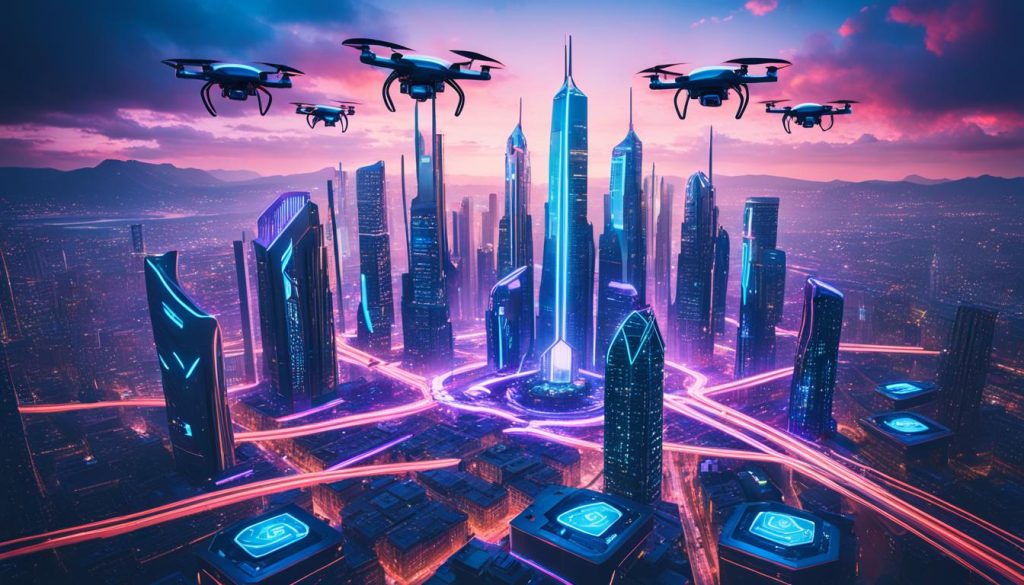
| Benefits | Implications |
|---|---|
| Improved AI model performance | Enhanced user experiences |
| Faster training and inference | Real-time decision making |
| Edge computing capabilities | Reduced latency, improved real-time insights |
| Cost-effectiveness | Accelerated training and enhanced efficiency |
| Future-proofing AI solutions | Transforming industries and driving innovation |
| AI-optimized hardware enables faster training and inference of AI models, improves performance, enhances user experiences, provides real-time decision-making capabilities, allows for edge computing, offers cost-effectiveness, accelerates training, enhances efficiency, and transforms industries by driving innovation. | |
How AI-Optimized Hardware Is Used in AI Robotics
AI-optimized hardware is revolutionizing the field of AI robotics, providing the necessary computational power and efficiency for AI algorithms to run on robotic systems. With the integration of AI-optimized hardware, robots can perceive and interpret their environment, make intelligent decisions, and perform complex tasks with precision and efficiency.
AI robotics is not limited to autonomous vehicles; it has expanded to various industries, including healthcare and industrial automation. Medical robots equipped with AI-optimized hardware enable precise surgeries, diagnostics, and patient care. In the industrial sector, robots with AI-optimized hardware automate repetitive tasks, enhance productivity, and ensure worker safety.
By leveraging AI-optimized hardware, robots are able to adapt to dynamic environments, learn from their experiences, and continuously improve their performance. This enables them to navigate through obstacles, understand human commands, and interact with their surroundings in real-time.
Applications of AI-Optimized Hardware in Robotics
The applications of AI-optimized hardware in robotics are diverse and impactful:
- Autonomous Vehicles: AI-optimized hardware enables self-driving cars to perceive their surroundings, recognize traffic patterns, and make informed decisions to ensure safe navigation.
- Medical Robotics: AI-optimized hardware empowers surgical robots to perform complex procedures with precision and accuracy, reducing the risk of human error.
- Industrial Automation: Robots equipped with AI-optimized hardware automate manufacturing processes, improving efficiency and productivity.
AI-optimized hardware in robotics not only enhances the performance of individual robots but also enables advanced AI algorithms to leverage the collective intelligence of robotic systems. This creates opportunities for collaboration, swarm robotics, and multi-agent coordination, further expanding the capabilities of AI-powered robotics.
The Future of AI-Optimized Hardware in AI Robotics
The future of AI-optimized hardware in AI robotics looks promising. As technology continues to advance, AI-optimized hardware will become more efficient, powerful, and cost-effective. This will open doors to new possibilities, such as humanoid robots with human-like perception and interaction capabilities.
| Benefit | Explanation |
|---|---|
| Enhanced Efficiency | AI-optimized hardware enables robots to process information faster, resulting in quicker response times and improved efficiency. |
| Precision and Accuracy | AI-optimized hardware minimizes errors, allowing robots to perform tasks with greater precision and accuracy. |
| Real-Time Decision Making | With AI-optimized hardware, robots can analyze data in real-time and make informed decisions, enabling them to adapt to changing circumstances. |
| Improved Safety | AI-optimized hardware enhances the safety of robots and their interactions with humans, reducing the risk of accidents. |
As AI-optimized hardware continues to evolve and be integrated into AI robotics, we can expect even greater advancements and innovations in the field. AI-powered robots will become indispensable in various industries, transforming the way we work, live, and interact with technology.
Future Trends and Advancements in AI-Optimized Hardware
The future of AI-optimized hardware is primed for remarkable advancements and continuous innovation. With technology continuously evolving, AI hardware is poised to become increasingly powerful, energy-efficient, and cost-effective. Promising technologies such as quantum hardware, neuromorphic hardware, ASICs, and FPGAs are expected to undergo further refinement, pushing the boundaries of performance and customization.
As AI continues to integrate with emerging technologies, such as 5G and edge computing, new possibilities for AI applications will be unlocked. The convergence of AI hardware with these technologies will pave the way for faster, more efficient processing, enabling real-time decision-making and unleashing the full potential of artificial intelligence.
The future of AI-optimized hardware holds immense promise for industries across the globe. From healthcare to manufacturing, transportation to finance, the advancements in AI hardware will transform the way we live and work, revolutionizing processes, boosting productivity, and driving innovation at an unprecedented scale.
FAQ
What is the significance of AI hardware customization?
AI hardware customization plays a crucial role in optimizing neural network performance. It ensures that hardware is tailored to meet the specific demands of AI workloads, resulting in enhanced processing power and efficiency.
What are the advancements in AI hardware?
Specialized GPUs, Neural Processing Units (NPUs), and Edge Computing Devices are key advancements in AI hardware. These technologies optimize AI computations, improve performance, and enable real-time decision-making capabilities.
What are the technological trends in AI hardware?
Technological trends in AI hardware include Quantum Hardware, ASICs, Neuromorphic Hardware, and FPGAs. These advancements drive innovation in AI hardware and offer customized efficiency, enhanced computation capabilities, and improved performance.
How does AI-optimized hardware shape the future of AI deployment?
AI-optimized hardware contributes to improved processing power, efficiency, and real-time decision-making capabilities in AI deployment. It enables faster training and inference of AI models, reduces latency, and enhances privacy and security.
How is AI-optimized hardware used in AI robotics?
AI-optimized hardware provides the necessary computational power and efficiency for AI algorithms to run on robotic systems. It enables robots to perceive and interpret their environment, make intelligent decisions, and perform complex tasks with precision and efficiency.
What can we expect in the future of AI-optimized hardware?
The future of AI-optimized hardware holds immense potential for advancements and innovations. We can anticipate more powerful, energy-efficient, and cost-effective AI hardware, integration with emerging technologies like 5G and edge computing, and continuous advancements that will shape the future of artificial intelligence.

